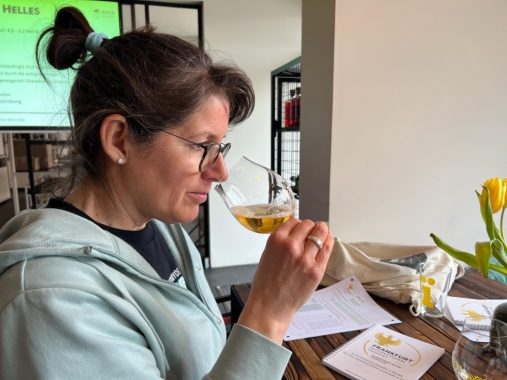
German beer sommelière and brewer
What excites Julia about the various beer flavours?
During a ‘beer tasting’ at the ‘Old Railroad Station’ in the suburbs of Cologne Julia explains to you the subtle nuances of this traditional German beverage – beer can taste fruity and malty or slightly tart and hoppy - and much more. Every Wednesday Julia and her brewer Rolf Oster produce about 2000 litre of craft beer at the family-owned brewery. As a renowned sommelier judge, she tastes und evaluates sometimes 35 different beers in one day. During this sensory marathon at international events, she describes and evaluates the last beer just as passionately as she started off with the first one. This is pure vocation & passion!
How do I become a beer sommelière?
Beer has been brewed in Julia's family for generations. But after studying biology, Julia first became interested in observing birds at the German coast. Fortunately, brewer Rolf Oster recognises her talent for identifying and describing flavours. And after the first ‘beer tasting’ session, she realises: the world of beers and brewing processes – how exciting is that! The next step is to professionally develop her knowledge and the associated sensory skills further. Julia enrols at the globally recognised ‘Doemens’ beer academy in Gräfeling near Munich. At the time the course to become a beer sommelière is offered in cooperation with ‘Axel Kiesbye's Bierkulturhaus’ in Obertrum, Austria.
In addition to the basics of the brewing process, the history of beer and the selection of basic ingredients is also part of the studies. The curriculum also includes many tasting rounds of rare and unusual beer specialities. Special subjects are: How do different glass shapes influence the enjoyment of beer through foam, flavour chimney and recency? How do I create a perfect combination of flavours from beers and food. And of course, the effects of beer enjoyment on body and mind, because beer is nevertheless an alcoholic beverage.
“As my taste is influenced by the different beers from my region, I had a lot of respect for the final ‘tasting’, as many Bavarian beers are known to be included in the test. The only thing that helps is to practise, practise and practise even more. In 2019, five women graduated from a total of 17 participants from all over Europe. But so far, I'm still the only woman in my region to hold this title. Since my first beer tasting, I have been collecting different beers all over Europe. I store them in my cellar for private tasting events. After all, beers can also mature and improve their flavour profile. Coming back to our family history - my husband's grandfather also trained as a brewer at the Doemens Academy in the 1920s. My father-in-law was also a passionate master brewer, and we still brew using his recipes in our newly build brewery.”
How can over 7500 different beers be brewed from 4 ingredients?
The 500-year-old German beer brewing ‘purity law’ is unique in the world. Around 7500 different beers are produced in Germany from water, malt, hops and yeast. Malt as a flavouring and colouring agent is produced by malting various types of grain. The international brewery community uses not only barley but also many other grains. The appropriate malt can be produced from any grain. In other countries, raw grain (unmalted grain) can also be used for brewing.
“In Mexico, local grown maize is often used in brewing, while rice is used in Asian countries. Last year we have also brewed a speciality craft beer with chestnut malt. Of course, we were not allowed to sell our creation as ‘Bier’ because of the German ‘Purity Law’. Compared to our European neighbours, the ‘Purity Law’ regulates very strictly which brewed liquid may carry the name ‘beer’. But the addition of spices, fruit extracts and barrel ageing can give the ‘fasting drink of nuns and monks’ a wonderful variety of flavours.”
How to be a beer sommelière and a brewer
To learn the craft, an experienced master brewer and hands-on experience in a brewery are important. But as with any craft, enthusiasm & passion for the product is the main motivation and a guarantee of success.
“The selection of hops alone is a science. Many facts influence the taste of hops: in which region with which soil conditions are the hops plant grown? How is the drying process? This and other factors have a huge influence on the flavour of the hops used in the brewing process. We refine our home-made craft beers with the excellent hop varieties (‘Perle’ and ‘Tettnanger’) from a small family owned business near Lake Constance – in the southern part of Germany. So far Germany is the top producer of hops next to the U.S. We have planted a small hop garden in our beer garden. Here we can show our guests that hops are one of the fastest growing plants on earth. The tendrils can grow up to eight metres high! The first hop fruits are harvested in August and stuffed into the beer.”
The newly built brewery
Wednesday is ‘brewing day’ in the brewery and 2000 litres of the two in-house beers named ‘Lokstoff’ - a light cloudy wheat beer and the clear ‘Finchen’ fill the steel tanks. In addition, there are the monthly changing beer specialities such as ‘bock beer’, Citra or an amber wheat. The 1- and 2-litre bottles and the 10-litre barrels (known as ‘Pittermännchen’) are rinsed, filled and labelled by hand. Genuine craftsmanship down to the last detail! The bottles and barrels are sold to customers wanting to enjoy the ‘Craft beers’ at home.
“When we renovated the old railway station, we laid a special pipe under the floor that runs from the brewery directly to the antique brass counter in the restaurant. There's no fresher way to tap beer. The old counter is a unique piece salvaged from a former railway station pub from the countryside. Almost every piece of furniture in our individual restaurant rooms tells a special story.”
Sense & Sensibility - a beer for the ‘International Women's Day’!
An exciting topic for Julia and her beer sommelière friends. Each of them brings something special to the ‘brew day’: Anja donates clear fresh spring water and Jutta brings Kazbek for the hop offering. The three sommeliers friends not only take time for the brewing but also for the impressive and mouthwatering description of their unique craft beer.
“In the glass, our beer is golden in colour, with the herbal, peppery aromas of angelica, coriander seeds and grains of paradise dancing on the tongue. You can clearly taste the typical bitter orange peel. At the same time, the cereal flakes provide a pleasantly velvety mouthfeel. A ‘Wit.ch’ with low drinking resistance that we hope everyone will enjoy.”
Their unique craft beer creation also tells the story of how women have been working as brewers since the Middle Ages. At the time of the witch hunts, these skilled and independent women were observed with envy and jealousy and their money-bringing business became their downfall.
“At the markets, these women were recognisable from afar thanks to their tall, pointed hats. Their large brewing kettles can be found in traditional images of ‘magic’ kettles as well as their cats, which protected the grain from mice. With our ‘Wit.ch’, brewed with raw fruits and spices, we would like to remind everyone of the story that many female brewers ended up on a pyre. The witch burning killed many talented women with / because of their unique knowledge.”
Julia and her favourite beer country!
Alongside Germany, it is of course Belgium - the country of a very diverse beer culture.
“Traditionally, the Belgian brewing community uses a variety of traditional refinement techniques. And they have created flavourful and special beers since the first monks starting their unique brewing processes. The Belgin way of brewing beer was protected as a World Heritage Site in 2016 following an application by the German-speaking communities. A great recognition of the work of many generations. In Germany, it's not the beer, but the art of craft brewing that is part of the intangible world cultural heritage.”
The beer community, Instagram and Julia
During the COVID lockdown, the whole business comes to a standstill from one day to the next. Time for Julia to give her usual working life new impetus - via Instagram.
“Our beers and our restaurant have been very well known locally for years and we hardly need any advertising. Instagram has given me the opportunity to get in touch with many beer experts and beer enthusiasts across Europe. The exchange about events such as beer tasting tours, speciality breweries, new trends, etc. works wonderfully here.”
“At the beginning of May, I was travelling with my community in Belgium – south-east of Brussels. We tasted many unusual beers at special lambic (‘sour’ beer) breweries and ‘stekerijen’ (beer blenders). In contrast to German wheat beer, un-malted wheat is also used. Wild yeasts start the fermentation process in shallow, open vats, the so-called cooling vessels. Various wooden barrels are used for further storage, which, as with whisky, ensure a special flavour profile. For fruit lambics, different fruits are used for secondary fermentation. For the ‘Steken’ process, various lambics (fresh sour beer) are blended with lambics that are at least 6 months old. This creation is called ‘Gueuze’ and is allowed to mature in oak barrels for years until the ‘Steker’ (the master blender) decides that it is ready for consumption. This long time that the beer is given to develop is simply fantastic and results in very diverse & unique flavours.”
How many different flavours can a beer sommelière detect?
At the ‘Women's International Trophy’ in Mainz, Julia tastes, describes and assesses 35 different beers in just one day. The international jury consists only of women, who judge premium wines, beers and spirits from all over the world that are submitted at the highest level. Julia is working also at other European events – her unique talent is on demand.
“Last year I was invited as an expert to the international wine, beer and spirits competition ‘Concours International de Lyon’. I was overwhelmed by the quality of the beers and other products submitted. At each international event I'm also enriched and inspired by the dialogue with my colleagues. We all love to share our passion.”
What are Julia's goals for 2024?
‘We received special recognition for our brewery and our craft back in April. The state of Northrhein-Westfalia awarded our brewery and seven other breweries the ‘Meister.Werk.NRW’ (Master producer) prize of honour for the food trade in 2024. Among other things, we were recognised for our sustainable business management, careful selection of (preferably regional) raw materials and regional commitment.”
A special honour for the whole family, who took the plunge into self-employment in 2012. Restoring the old, abandoned railway station and outbuildings with an enormous amount of personal effort was tough. All made possible in such a short time because of many helping hands from friends and family. The newly added brewery with the latest state of the art technology enables Julia and Rolf a brewing process at a high level. The regional concept of the in-house brewery, pub and restaurant is attracting a steadily growing clientele. An absolute countertrend to the facts in Germany that fewer and fewer people are drinking beer and that small pubs in rural areas are closing due to a lack of customers.
Julia's has already set her second goal for 2024.
“I've registered for the ‘German Beer Sommelier Championships’ in September. It takes place every two years and I've been practising & tasting lots of different international beer styles and new flavours with my training group for the past months. Of course, as a beer sommelière I love to train my sensory skills intensively. And there is always a way to improve my aroma memory.”
Julia and her ‘beer’ events
Would you like to immerse yourself in the diverse world of beer flavours – explained by Julia? Or learn about the brewing process and the specialities of the ingredients? And during these event also hear about the history of beer brewing or which new beer trends are coming up? Well you will be truly impressed by Julia's amazing knowledge.
“Beer tasting is a sensual process! Many people are surprised at how much they can taste, smell, see and feel with my guidance! Even the brewing process with ‘only’ 4 ingredients holds many amazing facts.”
What else could Julia tell you?
For example: Why did nuns and monks brew beer in the Middle Ages?
"During Lent, members of the order were only allowed to eat very little. The nuns and monks were therefore keen to produce beers that were as filling as possible. Because: ‘liquids’ do not break the fast. The abbess Hildegard von Bingen was one of the first to investigate and write down the influence of hops on health. She lived to be over 80 years old and gave us the good advice: ‘Cervisiam bibat - drink beer’. Of course, at this time beer had much less alcohol than it has nowadays."
Or that there are now more breweries in France (2500) than in Germany (1500). It seems that the French ‘love-to-drink’ beer community is also willing to pay a reasonable price for handmade craft beers. In Germany there is still room to improve that.
The location 'The old Railroad station'
Julia's enthusiasm for her craft and stylish beer consumption is also reflected in the lovingly designed and restored building and grounds – called now the ‘The old station’. The various rooms with their unique themes and furniture pieces as well as the beer garden by the old railway tracks offer a wonderful ambience to enjoy the in-house craft beers. They taste great at any time of year.
Passion & dedication - Julia has found her calling. Although there is still the idea of spending a season watching the shore birds at the German seaside.

Name: Julia Trunz
She is: Beer Sommelière & Beer Brewery, She has an MA in Biologie
She can be found: at the family owned brewery & restaurant 'Alten Bahnhof' in Frechen, in the suburbs of Cologne, Germany
Her WIASOLA advice: Learn! Broaden your horizons. Believe in yourself. Network and talk to each other. This is often easier with a good beer.
Her favourite 5 Craft beers at the moment (in brackets: the beer brewing style )
- Our beer 'Wit.ch' -for the Internation Women's Day (Wit)
- Our 'Lokstoff' (Wheat beer)
- 'Symbiose' by Boerenerf (Blended Lambic with home made Cider und honey wine Met)
- 'Super A' Art Bier #5 by Maisels & Friends (New England IPA)
- 'Abt 12' by St. Bernadus (Quadruple)
To be found:
Interesting links:
The 2 beer sommeliere friends Jutta Knoll and Anja Knober-Stegemann who helped to create the unique craft beer
Info:
Malt is grain or pseudo-grain that has been briefly germinated and then dried again. This process, known as malting, forms and activates enzymes in the grain that are necessary for brewing beer, for example.